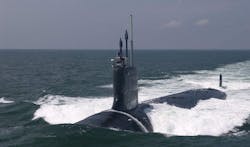Navy asks Lockheed Martin to upgrade and sustain electro-optical submarine surveillance and imaging system
WASHINGTON – Submarine combat systems experts at Lockheed Martin Corp. will continue to support and upgrade a U.S. Navy electro-optical surveillance system designed for several classes of attack and guided-missile submarines.
Officials of the Naval Sea Systems Command in Washington announced an $15.6 million order earlier this month to the Lockheed Martin Rotary and Mission Systems segment in Manassas, Va., for engineering support and component procurements for the Integrated Submarine Imaging System. (ISIS).
This electro-optical system provides mission-critical, all-weather, visual, and electronic search, digital image management, indication, warning, and platform architecture interface capabilities for Los Angeles-, Ohio-, and Virginia-class submarine vessels, Navy officials say. The system has the potential for installation on current and future ballistic missile submarines.
The ISIS submarine electro-optical surveillance system rolls-up existing components and near-term capabilities into an architecture for inserting future capabilities as they become available, including items taken from the Virginia-class submarine photonics program, Navy officials say.
ISIS is a backfit system to integrate all imaging capabilities on existing Navy submarine classes. It is part of the Navy's submarine Photonics Imaging System, a non-hull-penetrating replacement for existing optical periscopes. The Photonics Imaging System uses a wide portion of the electromagnetic spectrum with advanced daylight cameras, infrared thermal imaging sensors, and communications intercept and electronic warfare support.
The ISIS program seeks to replace the optical light path of existing submarine periscopes with high-definition cameras and fiber optic digital imagery. the project seeks to use infrared cameras for image enhancement, provide active and passive range finding control, and install image enhancement capabilities and analysis tools for real time and recorded imagery.
The ISIS program also will provide Navy submarines with image recording, storage, and recall capabilities, as well as provide the ability to transmit imagery off the submarine to other naval and joint forces.
ISIS revolutionizes Navy submarine surveillance capabilities by integrating digital video and still images from devices on a submarine's exterior and presenting real-time imagery and analysis on existing control room tactical displays.
ISIS provides digital image enhancement for data from a modern submarine's photonics mast, which uses optical fiber to move imaging data from a raised mast aboard a submerged submarine through tiny openings in the submarine's hull to tactical displays around the interior of the vessel.
The photonics mast replaces or augments the traditional periscope aboard U.S. submarines. The photonics mast not only replaces the large opening in the submarine pressure hull necessary for the optics and hydraulics of a traditional periscope, but also can blend image data from several kinds of electro-optical sensors aboard the photonics mast, including visible-light and infrared cameras.
The ISIS system enables submarine crew members to manipulate a photonics mast with a joystick, while looking at digital video on a computer monitor, and share that video real-time with the submarine's combat team on various displays aboard the vessel.
On this order Lockheed Martin will do the work in Manassas, Virginia Beach, and Arlington Va.; Orlando and Clearwater, Fla.; and Andover, Mass., and should be finished by September 2024. For more information contact Lockheed Martin Rotary and Mission Systems online at www.lockheedmartin.com/en-us/who-we-are/business-areas/rotary-and-mission-systems.html, or Naval Sea Systems Command at www.navsea.navy.mil.
About the Author
John Keller
Editor-in-Chief
John Keller is the Editor-in-Chief, Military & Aerospace Electronics Magazine--provides extensive coverage and analysis of enabling electronics and optoelectronic technologies in military, space and commercial aviation applications. John has been a member of the Military & Aerospace Electronics staff since 1989 and chief editor since 1995.
